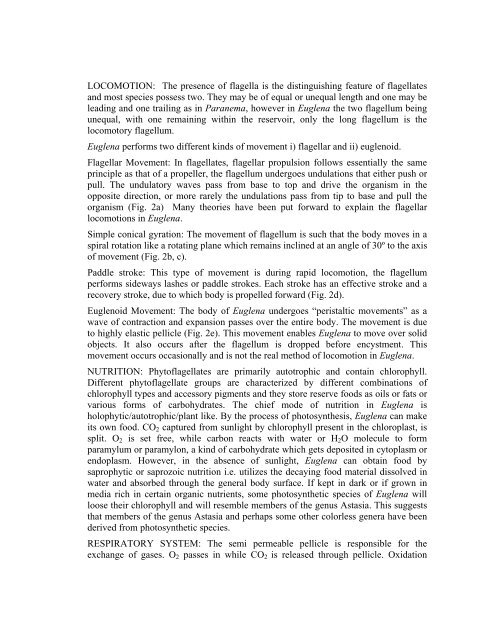ANIMAL DIVERSITY – I (NON-CHORDATES)
ANIMAL DIVERSITY – I (NON-CHORDATES)
ANIMAL DIVERSITY – I (NON-CHORDATES)
You also want an ePaper? Increase the reach of your titles
YUMPU automatically turns print PDFs into web optimized ePapers that Google loves.
LOCOMOTION: The presence of flagella is the distinguishing feature of flagellates<br />
and most species possess two. They may be of equal or unequal length and one may be<br />
leading and one trailing as in Paranema, however in Euglena the two flagellum being<br />
unequal, with one remaining within the reservoir, only the long flagellum is the<br />
locomotory flagellum.<br />
Euglena performs two different kinds of movement i) flagellar and ii) euglenoid.<br />
Flagellar Movement: In flagellates, flagellar propulsion follows essentially the same<br />
principle as that of a propeller, the flagellum undergoes undulations that either push or<br />
pull. The undulatory waves pass from base to top and drive the organism in the<br />
opposite direction, or more rarely the undulations pass from tip to base and pull the<br />
organism (Fig. 2a) Many theories have been put forward to explain the flagellar<br />
locomotions in Euglena.<br />
Simple conical gyration: The movement of flagellum is such that the body moves in a<br />
spiral rotation like a rotating plane which remains inclined at an angle of 30º to the axis<br />
of movement (Fig. 2b, c).<br />
Paddle stroke: This type of movement is during rapid locomotion, the flagellum<br />
performs sideways lashes or paddle strokes. Each stroke has an effective stroke and a<br />
recovery stroke, due to which body is propelled forward (Fig. 2d).<br />
Euglenoid Movement: The body of Euglena undergoes “peristaltic movements” as a<br />
wave of contraction and expansion passes over the entire body. The movement is due<br />
to highly elastic pellicle (Fig. 2e). This movement enables Euglena to move over solid<br />
objects. It also occurs after the flagellum is dropped before encystment. This<br />
movement occurs occasionally and is not the real method of locomotion in Euglena.<br />
NUTRITION: Phytoflagellates are primarily autotrophic and contain chlorophyll.<br />
Different phytoflagellate groups are characterized by different combinations of<br />
chlorophyll types and accessory pigments and they store reserve foods as oils or fats or<br />
various forms of carbohydrates. The chief mode of nutrition in Euglena is<br />
holophytic/autotrophic/plant like. By the process of photosynthesis, Euglena can make<br />
its own food. CO2 captured from sunlight by chlorophyll present in the chloroplast, is<br />
split. O2 is set free, while carbon reacts with water or H2O molecule to form<br />
paramylum or paramylon, a kind of carbohydrate which gets deposited in cytoplasm or<br />
endoplasm. However, in the absence of sunlight, Euglena can obtain food by<br />
saprophytic or saprozoic nutrition i.e. utilizes the decaying food material dissolved in<br />
water and absorbed through the general body surface. If kept in dark or if grown in<br />
media rich in certain organic nutrients, some photosynthetic species of Euglena will<br />
loose their chlorophyll and will resemble members of the genus Astasia. This suggests<br />
that members of the genus Astasia and perhaps some other colorless genera have been<br />
derived from photosynthetic species.<br />
RESPIRATORY SYSTEM: The semi permeable pellicle is responsible for the<br />
exchange of gases. O2 passes in while CO2 is released through pellicle. Oxidation
















